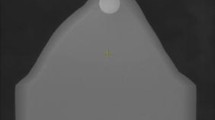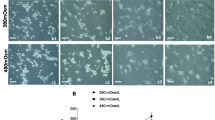Abstract
Objective The increasing concentration of proteoglycans from the surface to the deep zone of articular cartilage produces a depth-dependent gradient in fixed charge density, and therefore extracellular osmolarity, which may vary with loading conditions, growth and development, or disease. In this study we examine the relationship between in situ variations in osmolarity on chondrocyte water transport properties. Chondrocytes from the depth-dependent zones of cartilage, effectively preconditioned in varying osmolarities, were used to probe this relationship. Design First, depth variation in osmolarity of juvenile bovine cartilage under resting and loaded conditions was characterized using a combined experimental/theoretical approach. Zonal chondrocytes were isolated into two representative “baseline” osmolarities chosen from this analysis to reflect in situ conditions. Osmotic challenge was then used as a tool for determination of water transport properties at each of these baselines. Cell calcium signaling was monitored simultaneously as a preliminary examination of osmotic baseline effects on cell signaling pathways. Results Osmotic baseline exhibits a significant effect on the cell membrane hydraulic permeability of all zonal subpopulations but not on cell water content or incidence of calcium signaling. Conclusions Chondrocyte properties can be sensitive to changes in baseline osmolarity, such as those occurring during OA progression (decrease) and de novo tissue synthesis (increase). Care should be taken in comparing chondrocyte properties across zones when cells are tested in vitro in non-physiologic culture media.







Similar content being viewed by others
References
Ateshian G. A. Anisotropy of fibrous tissues in relation to the distribution of tensed and buckled fibers. J. Biomech. Eng. 2007, 129, 240–249
Ateshian G. A., K. D. Costa, C. T. Hung. A theoretical analysis of water transport through chondrocytes. Biomech. Model Mechanobiol. 6: 91–101, 2007
Ateshian G. A., B. J. Ellis, J. A. Weiss. Equivalence between short-time biphasic and incompressible elastic material responses. J. Biomech. Eng. 129: 405–412, 2007
Ateshian G. A., M. Likhitpanichkul, C. T. Hung. A mixture theory analysis for passive transport in osmotic loading of cells. J. Biomech. 39: 464–475, 2006
Ateshian, G. A., V. Rajan, N. O. Chahine, C. E. Canal, and C. T. Hung. Modeling the matrix of articular cartilage using a continuous fiber angular distribution predicts many observed phenomena. J. Biomech. Eng. (in review)
Aydelotte M. B., R. R. Greenhill, K. E. Kuettner. Differences between sub-populations of cultured bovine articular chondrocytes. II. Proteoglycan metabolism. Connect. Tissue Res. 18: 223–234, 1988
Aydelotte M. B., K. E. Kuettner. Differences between sub-populations of cultured bovine articular chondrocytes. I. Morphology and cartilage matrix production. Connect. Tissue Res. 18: 205–222, 1988
Azeloglu E. U., M. B. Albro, V. A. Thimmappa, G. A. Ateshian, K. D. Costa. Heterogeneous transmural proteoglycan distribution provides a mechanism for regulating residual stresses in the aorta. Am. J. Physiol. Heart Circ. Physiol. 294: H1197–H1205, 2008
Burton-Wurster N., M. Vernier-Singer, T. Farquhar, G. Lust. Effect of compressive loading and unloading on the synthesis of total protein, proteoglycan, and fibronectin by canine cartilage explants. J. Orthop. Res. 11: 717–729, 1993
Bush P. G., A. C. Hall. The osmotic sensitivity of isolated and in situ bovine articular chondrocytes. J. Orthop. Res. 19: 768–778, 2001
Bush P. G., A. C. Hall. Regulatory volume decrease (RVD) by isolated and in situ bovine articular chondrocytes. J. Cell. Physiol. 187: 304–314, 2001
Byers, B. A., R. L. Mauck, I. E. Chiang, and R. S. Tuan. Transient exposure to transforming growth factor beta 3 under serum-free conditions enhances the biomechanical and biochemical maturation of tissue-engineered cartilage. Tissue Eng. Part A, 2008
Chao P. G., Z. Tang, E. Angelini, A. C. West, K. D. Costa, C. T. Hung. Dynamic osmotic loading of chondrocytes using a novel microfluidic device. J. Biomech. 38: 1273–1281, 2005
Chao P. H., A. C. West, C. T. Hung. Chondrocyte intracellular calcium, cytoskeletal organization, and gene expression responses to dynamic osmotic loading. Am. J. Physiol. Cell. Physiol. 291: C718–C725, 2006
Darling E. M., S. Zauscher, F. Guilak. Viscoelastic properties of zonal articular chondrocytes measured by atomic force microscopy. Osteoarthritis Cartilage 14: 571–579, 2006
Elmoazzen H. Y., J. A. Elliott, L. E. McGann. The effect of temperature on membrane hydraulic conductivity. Cryobiology 45: 68–79, 2002
Erickson G. R., L. G. Alexopoulos, F. Guilak. Hyper-osmotic stress induces volume change and calcium transients in chondrocytes by transmembrane, phospholipid, and G-protein pathways. J. Biomech. 34: 1527–1535, 2001
Farndale R. W., D. J. Buttle, A. J. Barrett. Improved quantitation and discrimination of sulphated glycosaminoglycans by use of dimethylmethylene blue. Biochim. Biophys. Acta 883: 173–177, 1986
Freed L. E., J. C. Marquis, A. Nohria, J. Emmanual, A. G. Mikos, R. Langer. Neocartilage formation in vitro and in vivo using cells cultured on synthetic biodegradable polymers. J. Biomed. Mater. Res. 27: 11–23, 1993
Frijns A. J. H., J. M. Huyghe, J. D. Janssen. Validation of the quadriphasic mixture theory for intervertebral disc tissue. Int. J. Eng. Sci. 35: 1419–1429, 1997
Guilak F., G. R. Erickson, H. P. Ting-Beall. The effects of osmotic stress on the viscoelastic and physical properties of articular chondrocytes. Biophys. J. 82: 720–727, 2002
Guilak F., A. Ratcliffe, V. C. Mow. Chondrocyte deformation and local tissue strain in articular cartilage: a confocal microscopy study. J. Orthop. Res. 13: 410–421, 1995
Hopewell B., J. P. Urban. Adaptation of articular chondrocytes to changes in osmolality. Biorheology 40: 73–77, 2003
Hung C. T., M. A. LeRoux, G. D. Palmer, P. H. Chao, S. Lo, W. B. Valhmu. Disparate aggrecan gene expression in chondrocytes subjected to hypotonic and hypertonic loading in 2D and 3D culture. Biorheology 40: 61–72, 2003
Kedem O., A. Katchalsky. Thermodynamic analysis of the permeability of biological membranes to non-electrolytes. Biochim. Biophys. Acta 27: 229–246, 1958
Kerrigan M. J., A. C. Hall. Control of chondrocyte regulatory volume decrease (RVD) by [Ca(2+)](i) and cell shape. Osteoarthritis Cartilage 16: 312–322, 2008
Kerrigan M. J., C. S. Hook, A. Qusous, A. C. Hall. Regulatory volume increase (RVI) by in situ and isolated bovine articular chondrocytes. J. Cell. Physiol. 209: 481–492, 2006
Kim T. K., B. Sharma, C. G. Williams, M. A. Ruffner, A. Malik, E. G. McFarland, J. H. Elisseeff. Experimental model for cartilage tissue engineering to regenerate the zonal organization of articular cartilage. Osteoarthritis Cartilage 11: 653–664, 2003
Lai W. M., J. S. Hou, V. C. Mow. A triphasic theory for the swelling and deformation behaviors of articular cartilage. J. Biomech. Eng. 113: 245–258, 1991
Lanir Y. Constitutive equations for fibrous connective tissues. J. Biomech. 16: 1–12, 1983
Lucke B., M. McCutcheon. The living cell as an osmotic system and its permeability to water. Physiol. Rev. 12: 68–138, 1932
Malgaroli A., D. Milani, J. Meldolesi, T. Pozzan. Fura-2 measurement of cytosolic free Ca2+ in monolayers and suspensions of various types of animal cells. J. Cell. Biol. 105: 2145–2155, 1987
Maroudas A., H. Evans. A study of ionic equilibria in cartilage. Connect. Tissue Res. 1: 69–77, 1972
Maroudas A., I. Ziv, N. Weisman, M. Venn. Studies of hydration and swelling pressure in normal and osteoarthritic cartilage. Biorheology 22: 159–169, 1985
Marshall K. W., D. J. Mikulis, B. M. Guthrie. Quantitation of articular cartilage using magnetic resonance imaging and three-dimensional reconstruction. J. Orthop. Res. 13: 814–823, 1995
Mauck R. L., S. B. Nicoll, S. L. Seyhan, G. A. Ateshian, C. T. Hung. Synergistic action of growth factors and dynamic loading for articular cartilage tissue engineering. Tissue Eng. 9: 597–611, 2003
McGann L. E., M. Stevenson, K. Muldrew, N. Schachar. Kinetics of osmotic water movement in chondrocytes isolated from articular cartilage and applications to cryopreservation. J. Orthop. Res. 6: 109–115, 1988
Mobasheri A., E. Trujillo, S. Bell, S. D. Carter, P. D. Clegg, P. Martin-Vasallo, D. Marples. Aquaporin water channels AQP1 and AQP3, are expressed in equine articular chondrocytes. Vet. J. 168: 143–150, 2004
Mow V. C., S. C. Kuei, W. M. Lai, C. G. Armstrong. Biphasic creep and stress relaxation of articular cartilage in compression? Theory and experiments. J. Biomech. Eng. 102: 73–84, 1980
Overbeek J. T. The Donnan equilibrium. Prog. Biophys. Biophys. Chem. 6: 57–84, 1956
Palmer G. D., P. H. Chao, Ph. F. Raia, R. L. Mauck, W. B. Valhmu, C. T. Hung. Time-dependent aggrecan gene expression of articular chondrocytes in response to hyperosmotic loading. Osteoarthritis Cartilage 9: 761–770, 2001
Ponder E. 1948. Hemolysis and Related Phenomena. New York: Grune and Stratton. 398 pp
Pritchard, S., B. J. Votta, S. Kumar, and F. Guilak. Interleukin-1 inhibits osmotically induced calcium signaling and volume regulation in articular chondrocytes. Osteoarthritis Cartilage, 2008
Riesle J., A. P. Hollander, R. Langer, L. E. Freed, G. Vunjak-Novakovic. Collagen in tissue-engineered cartilage: types, structure, and crosslinks. J. Cell. Biochem. 71: 313–327, 1998
Sanchez J. C., R. J. Wilkins. Changes in intracellular calcium concentration in response to hypertonicity in bovine articular chondrocytes. Comp. Biochem. Physiol. A Mol. Integr. Physiol. 137: 173–182, 2004
Shieh A. C., K. A. Athanasiou. Biomechanics of single zonal chondrocytes. J. Biomech. 39: 1595–1602, 2006
Ting-Beall H. P., D. Needham, R. M. Hochmuth. Volume and osmotic properties of human neutrophils. Blood 81: 2774–2780, 1993
Torzilli P. A., R. Grigiene, C. Huang, S. M. Friedman, S. B. Doty, A. L. Boskey, G. Lust. Characterization of cartilage metabolic response to static and dynamic stress using a mechanical explant test system. J. Biomech. 30: 1–9, 1997
Urban J. P., A. C. Hall, K. A. Gehl. Regulation of matrix synthesis rates by the ionic and osmotic environment of articular chondrocytes. J. Cell. Physiol. 154: 262–270, 1993
Venn M., A. Maroudas. Chemical composition and swelling of normal and osteoarthrotic femoral head cartilage. I. Chemical composition. Ann. Rheum. Dis. 36: 121–129, 1977
Yellowley C. E., J. C. Hancox, H. J. Donahue. Effects of cell swelling on intracellular calcium and membrane currents in bovine articular chondrocytes. J. Cell. Biochem. 86: 290–301, 2002
Youn I., J. B. Choi, L. Cao, L. A. Setton, F. Guilak. Zonal variations in the three-dimensional morphology of the chondron measured in situ using confocal microscopy. Osteoarthritis Cartilage 14: 889–897, 2006
Acknowledgments
This study was supported by the National Institute of Arthritis and Musculoskeletal and Skin Diseases of the National Institutes of Health, USA (AR052871) and by an NSF Graduate Research Fellowship (ESO). The authors wish to thank Richard Shin, Angie Cheng, Pojen Deng, Sarah Kramer, and David Mao for performing image analysis and biochemical assays.
Author information
Authors and Affiliations
Corresponding author
Rights and permissions
About this article
Cite this article
Oswald, E.S., Chao, PH.G., Bulinski, J.C. et al. Dependence of Zonal Chondrocyte Water Transport Properties on Osmotic Environment. Cel. Mol. Bioeng. 1, 339–348 (2008). https://doi.org/10.1007/s12195-008-0026-6
Received:
Accepted:
Published:
Issue Date:
DOI: https://doi.org/10.1007/s12195-008-0026-6




